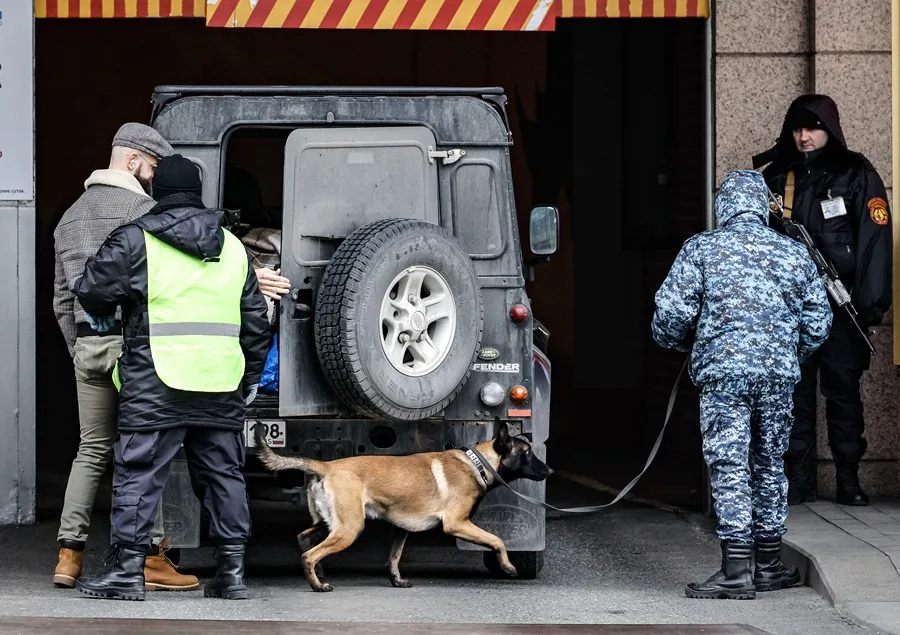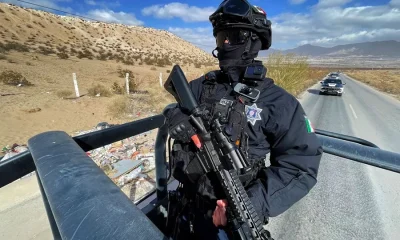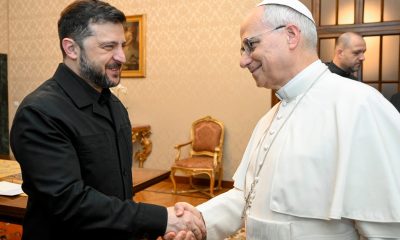International
A Russian general dies in the explosion of a car bomb near Moscow

Russian Lieutenant General Yaroslav Moskalik, senior command of the General Staff, died this Friday due to the explosion of a car bomb in the Moscow region, according to the Russian Instruction Committee (CIR).
“According to preliminary data, Lieutenant General Yaroslav Moskalik died as a result of the explosion,” Svetlana Petrenko, a CIR spokeswoman, told local media.
Moskalik, deputy chead of the operations command of the General Staff of the Russian Armed Forces since 2021, died when approaching a car, a Volkswagen Golf, in which an explosive device was remotely detonated, according to Mash and Shot, two Telegram channels.
“The reason for the explosion was an explosive device. Fragments of the device were found at the scene of the accident,” a police source told the TASS agency.
The newspaper Kommersant suggests that a second person could have died in the attack, although other media do not report that possibility.
The sources cited by another channel, BAZA, speak of a gas cylinder as the reason for the explosion equivalent to 300 grams of trilite.
Other media believe that the cylinder that was in the car amplified the power of the explosive, which caused damage to the cars parked in the vicinity and the windows of adjacent buildings.
According to the Mash channel, the last owner of the car, which was parked in front of the portal of the building where the general lived, was an individual from the Ukrainian city of Sumi.
The Instruction Committee opened a criminal case for murder and illegal possession of explosives, while the spokeswoman for Foreign Affairs, María Zajárova, called the incident a “terrorist attack”.
The explosion took place in the courtyard of an urbanization built east of the Russian capital especially for retired military personnel, where a team of investigators, criminals and other agents has already been sent to supervise the site of the attack.
The Russian media offered images of the powerful explosion of tourism at the pass of the 59-year-old general, who had been included in the Ukrainian Mirotvorets list in which “the enemies of Ukraine” appear.
In December of last year, Lieutenant General Igor Kirilov, head of Russia’s radiological, chemical and biological defense, also died in a bomb attack while leaving his home.
According to the Gazeta.ru portal, in both cases its authors studied in detail the routine, from the schedule to the route, which the victims followed daily.
Then, Russian President Vladimir Putin described this attack as a “serious failure” by the security services, who held the agents of the Ukrainian secret services responsible.
“This (the murder of Kirilov), of course, means that our law enforcement officers and special services let these attacks pass. We need to improve the work and avoid such serious failures,” he said.
In turn, shortly after, Russia’s Federal Security Service (FSB) claimed to have thwarted a series of attacks against senior military leaders in the country and reported the arrest of four Russian citizens as part of the investigation.
“The Russian Federal Security Service thwarted a series of attacks against high-ranking military personnel of the Ministry of Defense who participate in the special military operation (in Ukraine), as well as against members of their families,” the agency said.
International
U.S. and Mexico Reach Deal to Address Water Deficit Under 1944 Treaty

The United States and Mexico have reached an agreement to comply with current water obligations affecting U.S. farmers and ranchers and for Mexico to cover its water deficit to Texas under the 1944 Water Treaty, the U.S. Department of Agriculture said in a statement.
The department уточified that the agreement applies to both the current cycle and the water deficit from the previous cycle.
On Monday, U.S. President Donald Trump accused Mexico of failing to comply with the water-sharing treaty between the two countries, which requires the United States to deliver 1.85 billion cubic meters of water from the Colorado River, while Mexico must supply 432 million cubic meters from the Rio Grande.
Mexico is behind on its commitments. According to Washington, the country has accumulated a deficit of more than one billion cubic meters of water over the past five years.
“This violation is severely harming our beautiful crops and our livestock in Texas,” Trump wrote on Monday.
The Department of Agriculture said on Friday that Mexico had agreed to supply 250 million cubic meters of water starting next week and to work toward closing the shortfall.
Agriculture Secretary Brooke Rollins, quoted in the statement, said Mexico delivered more water in a single year than it had over the previous four years combined.
Trump has said that if Mexico continues to fall short of its obligations, the United States reserves the right to impose 5% tariffs on imported Mexican products.
Mexico’s Deputy Foreign Minister for North America, Roberto Velasco, said that a severe drought in 2022 and 2023prevented the country from meeting its commitments.
International
Several people shot in attack on Brown University campus

Several people were shot on Saturday in an attack on the campus of Brown University, in the northeastern United States, local police reported.
“Shelter in place and avoid the area until further notice,” the Providence Police Department urged in a post on X. Brown University is located in Providence, the capital of the state of Rhode Island.
U.S. President Donald Trump said on his social media platform Truth Social that he had been briefed on the situation and that the FBI was on the scene.
At 5:52 p.m. local time (11:52 p.m. GMT), Brown University said the situation was still “ongoing” and instructed students to remain sheltered until further notice.
After initially stating that the suspect had been taken into custody, Trump later posted a second message clarifying that local police had walked back that information. “The suspect has NOT been apprehended,” the U.S. president said.
International
Colombia says it would not reject Maduro asylum request as regional tensions escalate

The Colombian government stated on Thursday that it would have no reason to reject a potential asylum request from Venezuelan President Nicolás Maduro should he leave office, as regional tensions persist over the deployment of U.S. military forces in the Caribbean since August.
“In the current climate of tension, negotiations are necessary, and if the United States demands a transition or political change, that is something to be assessed. If such a transition results in him (Maduro) needing to live elsewhere or seek protection, Colombia would have no reason to deny it,” said Colombian Foreign Minister Rosa Villavicencio in an interview with Caracol Radio.
However, Villavicencio noted that it is unlikely Maduro would choose Colombia as a refuge. “I believe he would opt for someplace more distant and calmer,” she added.
Colombian President Gustavo Petro also commented on Venezuela’s situation on Wednesday, arguing that the country needs a “democratic revolution” rather than “inefficient repression.” His remarks followed the recent detention and passport cancellation of Cardinal Baltazar Porras at the Caracas airport.
“The Maduro government must understand that responding to external aggression requires more than military preparations; it requires a democratic revolution. A country is defended with more democracy, not more inefficient repression,” Petro wrote on X (formerly Twitter), in a rare public criticism of the Venezuelan leader.
Petro also called for a general amnesty for political opponents and reiterated his call for forming a broad transitional government to address Venezuela’s prolonged crisis.
Since September, U.S. military forces have destroyed more than 20 vessels allegedly carrying drugs in Caribbean and Pacific waters near Venezuela and Colombia, resulting in over 80 deaths.
U.S. President Donald Trump has repeatedly warned that attacks “inside Venezuela” will begin “soon,” while Maduro has urged Venezuelans to prepare for what he describes as an impending external aggression.
-

 International4 days ago
International4 days agoMexico City prepares for 13 million pilgrims at Basilica of Guadalupe
-

 International3 days ago
International3 days agoWashington declares State of Emergency as atmospheric river brings severe flooding
-

 International3 days ago
International3 days agoU.S. to require five-year social media history from tourists under Visa Waiver Program
-

 Central America4 days ago
Central America4 days agoHonduras’ electoral chief reports ongoing technical issues but says results remain intact
-

 Central America5 days ago
Central America5 days agoMexico and Guatemala launch joint security operation after Agua Zarca border attack
-

 Central America4 days ago
Central America4 days agoU.S. accuses Ortega regime of systematic human rights abuses in Nicaragua
-

 Central America4 days ago
Central America4 days agoU.S. finds no evidence of fraud in Honduras election despite delays
-

 Central America5 days ago
Central America5 days agoHonduran University: Nullifying elections without proof of fraud undermines popular sovereignty
-

 Central America3 days ago
Central America3 days agoOAS and EU urge honduran political actors to respect vote results and avoid unrest
-

 Central America5 days ago
Central America5 days agoCNA director says Libre’s defeat stems from “lack of substance,” not messaging
-

 International2 days ago
International2 days agoCuba battles out-of-control dengue and chikungunya epidemic as death toll rises to 44
-

 Central America2 days ago
Central America2 days agoHonduras election crisis deepens as CNE president denounces intimidation attempts
-

 International2 days ago
International2 days agoColombia says it would not reject Maduro asylum request as regional tensions escalate
-

 International5 days ago
International5 days agoZelensky meets Pope Leo XIV as review of U.S. peace plan continues
-

 International3 days ago
International3 days agoSix ecuadorian soldiers jailed pending trial for alleged extrajudicial execution
-

 International2 days ago
International2 days agoEcuador on track for record violence as homicides hit highest level in Latin America again
-

 International13 hours ago
International13 hours agoSeveral people shot in attack on Brown University campus
-

 International10 hours ago
International10 hours agoU.S. and Mexico Reach Deal to Address Water Deficit Under 1944 Treaty


























